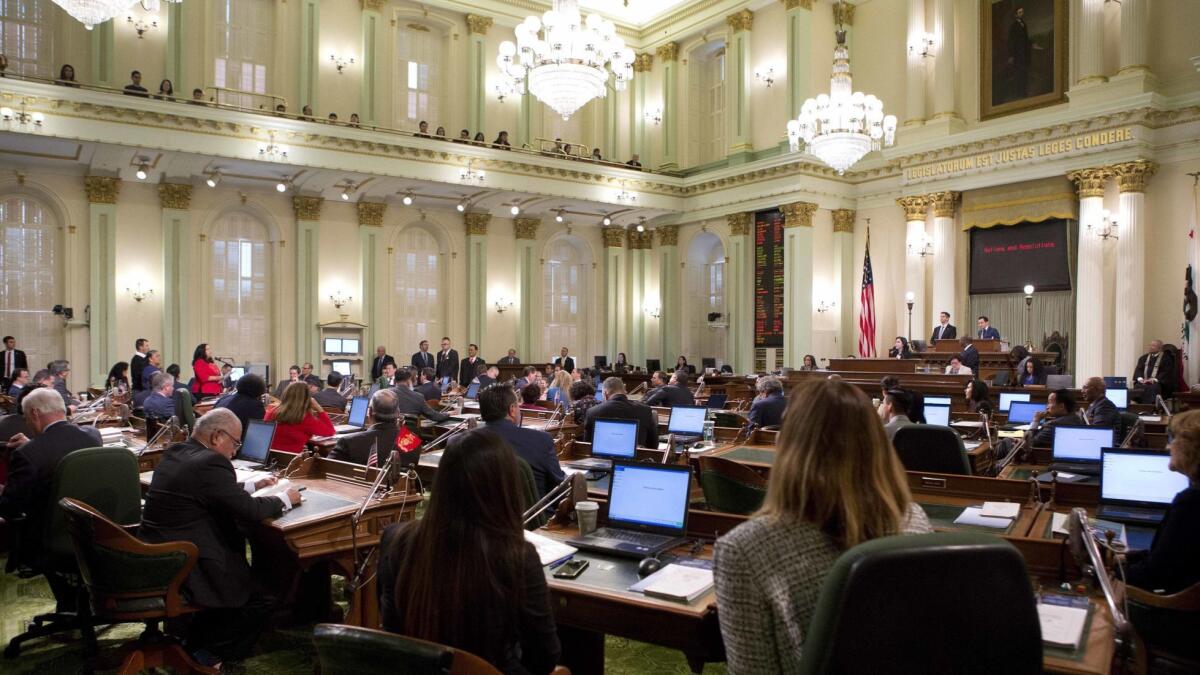Column: California lawmakers again protect the loophole of unlimited political cash

This isn’t meant to be a trick question: Are there limits to the size of campaign contributions that a California lawmaker can accept?
Yes, there are — unless the money is given to a political committee that’s supposed to either support or oppose a ballot measure. Then the answer is no; the politician can collect in donations of all sizes. And it’s been that way for almost two decades.
“It is time to close the loophole, so that candidates and elected officials cannot use money intended for promoting or opposing ballot measures to instead promote themselves and their campaigns,” state Sen. Patricia Bates (R-Laguna Niguel) told a Senate committee last month.
But it’s not going to change anytime soon, as Bates learned when the panel killed her Senate Bill 401 on a bipartisan vote. It was the fifth attempt since 2004 to stop what observers say is a campaign money maneuver that California voters unknowingly blessed through a ballot proposition in 2000.
Is California’s new voting system a success? We may not know until 2020 »
That measure, Proposition 34, was written by prominent Democratic and Republican lawmakers who promised it would do just as well as more strict limits that had been blocked in a federal court. But the proposition focused its attention only on candidate campaigns. Soon after, state lawmakers began raising money for ballot measures — the kind of campaign money that the U.S. Supreme Court ruled in 1981 poses no real risk of corruption and thus isn’t subject to contribution limits.
But in practice, the donors to a candidate’s campaign committee and ballot measure committee are often one and the same — interest groups seeking to curry favor or reward action. State campaign finance records show that 31 members of the Legislature — Democrats and Republicans alike — have active ballot measure campaign committees. Few have spent money to support or oppose a proposition; most spend it on things like political consultants, polling and travel. The rules don’t require the committee to ever engage in ballot measure politicking.
California regulators tried to impose candidate campaign donation limits to these committees in 2005, sparked by the ballot-measure fundraising of then-Gov. Arnold Schwarzenegger. But a state appeals court said that only the Legislature, not the state’s government watchdog agency, had the power to make such a sweeping change.
Which gets us back to SB 401, rejected after a fairly short debate in a state Senate committee. Lawmakers said they agreed that the issue deserved a closer look, but worried that Bates’ bill didn’t quite have the careful wording it might need to pass full constitutional muster when it comes to the idea that campaign cash is synonymous with political speech. They pledged to work with her, while still defeating the bill.
An even narrower effort by the GOP lawmaker failed passage in 2016, too, which suggests the problem isn’t so much the wording — rather, changing the rules might not be popular with colleagues who have taken six-figure donations to their own ballot measure committees.
To be fair, politician-controlled ballot measure committees are hardly the largest loophole that Proposition 34 created. That award goes to independent expenditure campaigns, California’s precursor to super PACs on the national level that can raise money in unlimited amounts to elect or defeat a politician, as long as there’s no coordination with the candidate.
If legislators won’t rein in the ballot-measure committees they now operate, then voters are the only ones who can. The problem is a statewide political campaign will cost millions — and those wanting to maintain the status quo have the upper hand in fundraising.
Follow @johnmyers on Twitter and sign up for our daily Essential Politics newsletter
More to Read
Get the L.A. Times Politics newsletter
Deeply reported insights into legislation, politics and policy from Sacramento, Washington and beyond. In your inbox three times per week.
You may occasionally receive promotional content from the Los Angeles Times.











